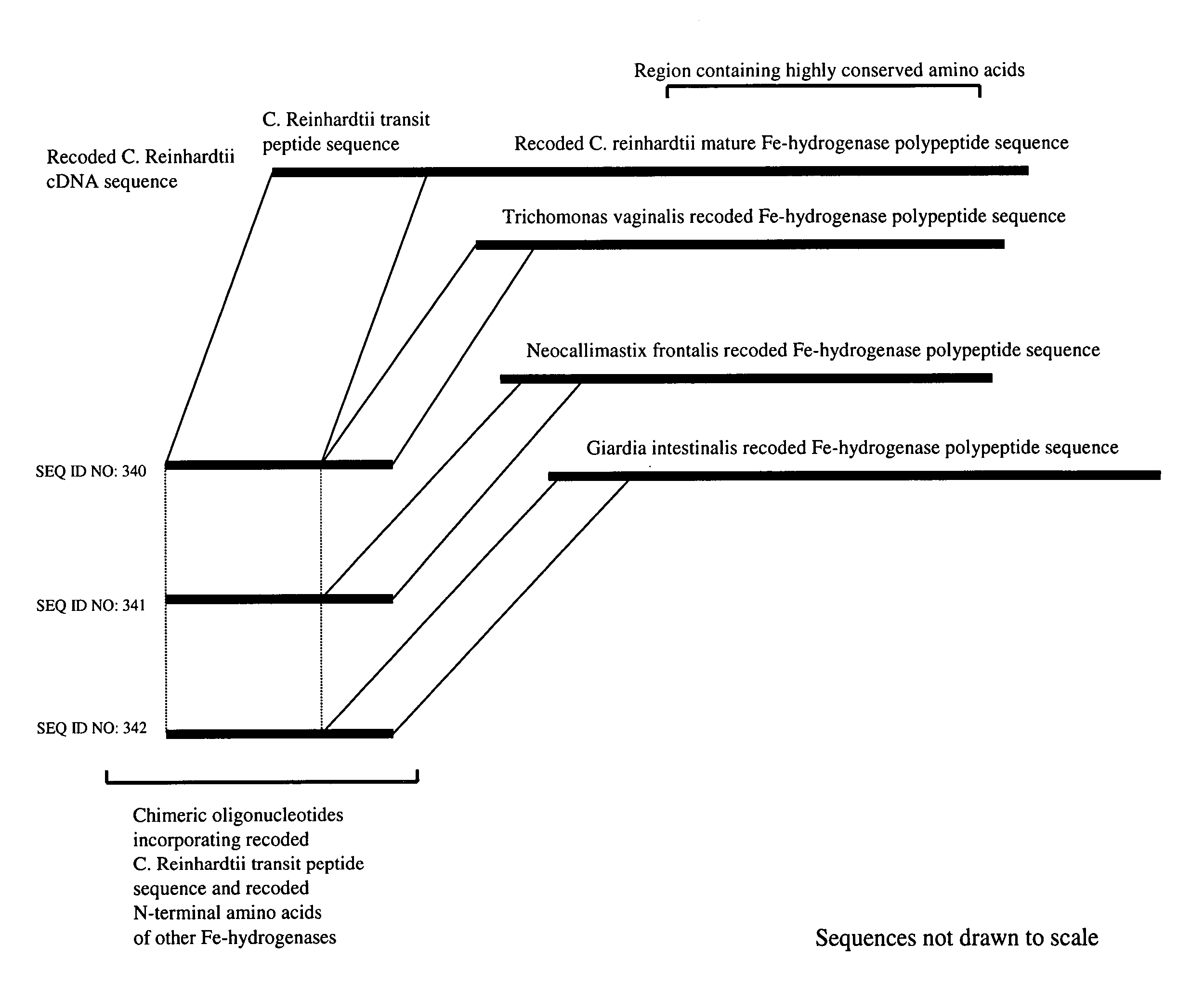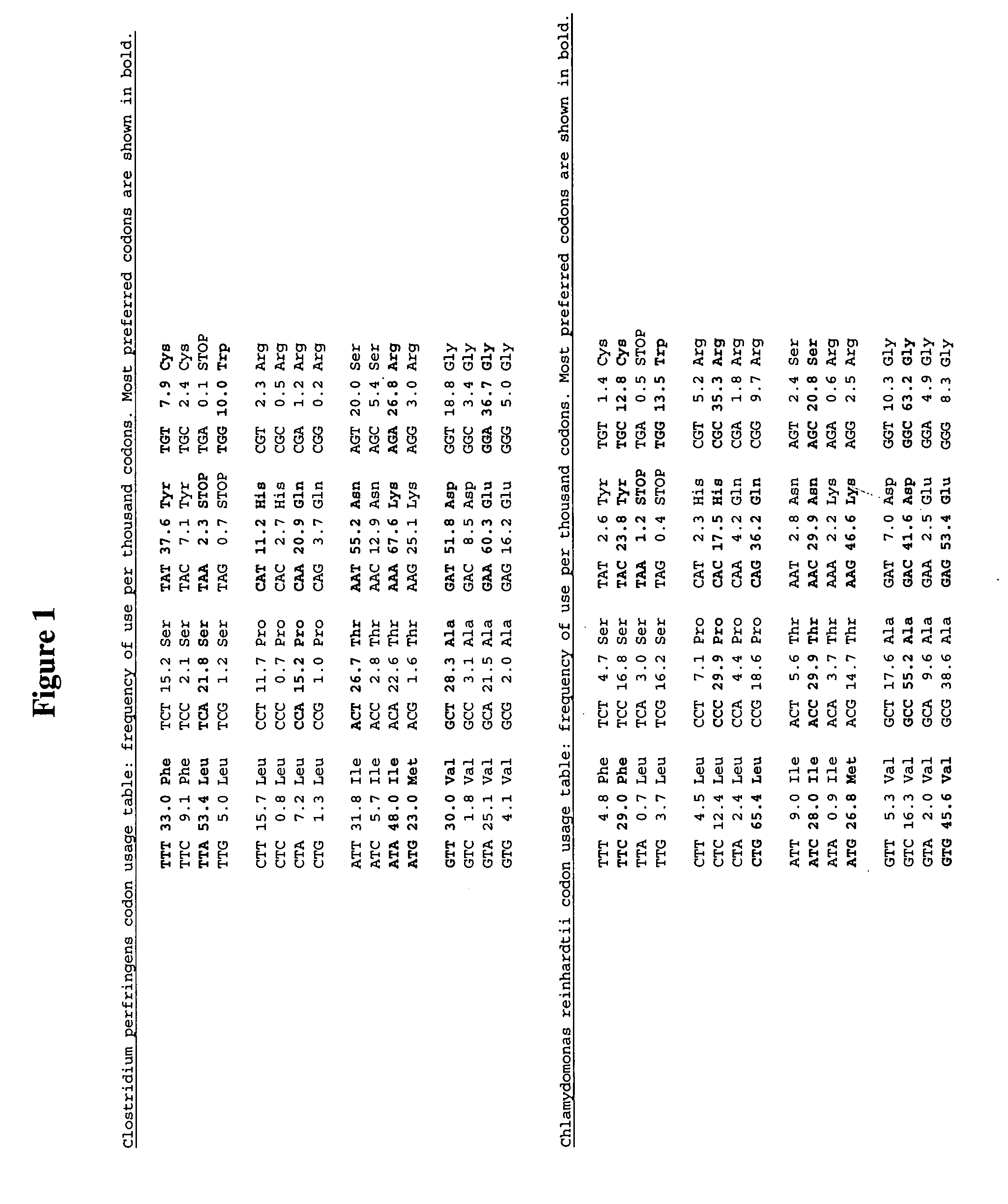Methods and compositions for evolving hydrogenase genes
a hydrogenase and gene technology, applied in the field of methods and compositions for evolving hydrogenase genes, can solve the problems of not identifying mutagenized versions of genes, unable to perform the desired function, etc., and achieve the effect of increasing the ability to accept electrons and increasing the ra
- Summary
- Abstract
- Description
- Claims
- Application Information
AI Technical Summary
Benefits of technology
Problems solved by technology
Method used
Image
Examples
example 1
[0131] The Clamydomonas reinhardtii Fe-hydrogenase amino acid sequence (SEQ ID NO: 24) was subjected to the Basic Local Alignment Sequence Tool (BLAST) at the National Center for Biotechnology Information. A total of 105 sequences were matched, all but one of which were distinct from the input sequence. A single self-match was reported as a 100% sequence identify. Parameters for the BLAST search were as follows: the peptide sequence database searched was the nr database (Database: All non-redundant GenBank CDS translations+PDB+SwissProt+PIR+PRF); Matrix: BLOSUM62; Gap Penalties: Existence: 11, Extension: 1. 87 unique protein sequences were identified that possess E values of 4e−05 or smaller (SEQ ID NOs: 1-87). Some proteins were identified that met the E value criteria but either did not appear to be hydrogenase genes, possessed significant homology to the C. reinhardtii Fe-hydrogenase protein but did not contain amino acids critical to the Fe-hydrogenase active site, or were posit...
example 2
[0133] A collection of NiFe-hydrogenase genes encoding hydrogenases that preferentially catalyze the formation of molecular hydrogen over the consumption of molecular Hydrogen were obtained that correspond to SEQ ID NOs: 185-194. These wild-type cDNA sequences correspond to the small and large subunit genes of the NiFe-hydrogenase catalytic heterodimer. The wild-type NiFe-hydrogenase cDNA sequences were recoded to utilize the same codon for each amino acid to generate SEQ ID NOs: 330-339. The cDNA sequences were recoded to utilize only the most preferred codons in E. coli strain K12, as illustrated in FIG. 13. A total of 2050 codons from SEQ ID NOs: 185-194 were recoded to most preferred E. coli strain K12 codons.
example 3
[0134] Nucleic acid sequences corresponding to SEQ ID NOs: 88-174 are recoded according to the most preferred codons in Chlamydomonas reinhardtii, as illustrated in FIG. 4, to generate nucleic acid sequences according to the sequences set forth in SEQ ID NOs: 195-281. Synthetic genes of SEQ ID NOs: 195-281 are created by annealing sense and antisense oligonucleotides corresponding to all segments of SEQ ID NOs: 195-281 followed by ligation and PCR, generally following the methods of Fuhrmann et al., Plant J 1999 August; 19(3):353-61. The genes are then cloned and maintained in expression vectors known in the art.
[0135] Using methods generally set forth in U.S. Pat. Nos. 5,605,793, 6,132,970, and 6,180,406, the synthetic genes of SEQ ID NOs: 195-281 are put through a reassembly protocol using cycles of denaturation, annealing, and extension. Clones of SEQ ID NOs: 195-281 are first fragmented using DNaseI. About 5 μg of the cloned genes are digested with 0.15 units of DNAseI (Sigma, ...
PUM
| Property | Measurement | Unit |
|---|---|---|
| pH | aaaaa | aaaaa |
| concentration | aaaaa | aaaaa |
| nucleic acid | aaaaa | aaaaa |
Abstract
Description
Claims
Application Information
 Login to View More
Login to View More - R&D
- Intellectual Property
- Life Sciences
- Materials
- Tech Scout
- Unparalleled Data Quality
- Higher Quality Content
- 60% Fewer Hallucinations
Browse by: Latest US Patents, China's latest patents, Technical Efficacy Thesaurus, Application Domain, Technology Topic, Popular Technical Reports.
© 2025 PatSnap. All rights reserved.Legal|Privacy policy|Modern Slavery Act Transparency Statement|Sitemap|About US| Contact US: help@patsnap.com



